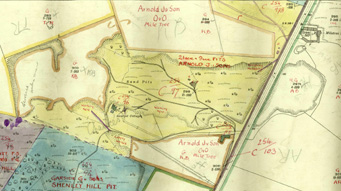
The 21 and 9 Acre pits in 1927 in yellow
Heath and Reach is dotted with a number of sand pits or quarries, some in use, some disused. Many of these were created by two principal local firms, J.Arnold & Sons Limited and George Garside (Sand) Limited. A number of these pits were north-west of the angle formed by Shenley Hill Road and Mile Tree Road. One of these was Nine Acres Pit, owned and worked by Arnold's.
In 1896 an article in Gardening World said of Nine Acre Pit: "Adjoining the Mile Tree Road Pit [Twenty One Acres] is the above. A large proportion of the sand has been taken out, and of late years the pit has been lying idle, but is to be continued again shortly. The pit is of easy access from the main road. On the top are 3 feet of soil, below which, in one place, is a pan of valuable iron-stone of a dark red or brown colour. The bulk of sand in this pit is used for filtering purposes and cement work, and as bird-sand, the latter being of a coarse, red description. Leaving this place we passed another of Mr.Arnold's farms, on which we noted a 56 acre field of sand which has not yet been opened, but is held in store for a future period and generation [probably Double Arches pit, opened in 1916]. Apparently it would furnish as much silver sand as would keep the horticultural world supplied till Domesday" [it closed in 1985].
In 1898 Joseph Arnold objected to the poor rate levied on the pit by the Leighton Buzzard Board of Guardians (who ran the workhouse and provided relief to the poor, using the poor rate monies). Bedfordshire & Luton Archives & Records Service has a lot of correspondence regarding this dispute [Z720/250 and BML10/42/290] and one of the records with the correspondence is a simple account for the pit showing that 9,516 tons were dug in the preceding year which, at a price three shillings and two pence per ton yielded £1,506.
Expenses, £907, were itemised as follows:
- Untopping and pushing down [i.e. uncovering the sand layers] at 3d. per ton: £120;
- Filling truck and drawing to loading stage at 2½d. per ton: £100;
- Filling and carrying at 1/5 per ton: £673;
- Interest on outlay on works: £14.
The Rating and Valuation Act 1925 ordered that every piece of land and building in the country be assessed to determine the rates to be paid upon it. The valuer visiting Nine Acres pit [DV1/C254/97-99] noted that with the neighbouring Twenty One Acres pit the total area worked was 23.450 acres. He noted: "Saw foreman 30/8/27. About fifteen men working. Pit first started about 35 years ago. Rails run into pits. Trucks pulled out to railway by horses. Average untopping 12 feet". Untopping is the process of removing the soil, or overburden, on the surface in order to reach the sand layers.
Buildings on the site comprised: a weather boarded and corrugated iron sifting shed measuring 12 feet by 45 feet by 16 feet; another weather boarded and corrugated iron sifting shed measuring 12 feet by 16 feet by 23 feet; 2 sifters; a corrugated iron lean-to shed; a weather boarded and corrugated iron shed; a corrugated iron lean-to engine shed and a Blackstone Oil Engine rated at four horsepower.
The valuer further noted: "These two pits "Nine Acres" and "Twenty-One Acres" adjoin but are worked separately. Nine Acres is old and apparently more expensive to work. Twenty One Acres is very good. One gang working on untopping another on getting out sand. Trucks pulled out of pit by motor and horses. Separate rails for untopping. On light railway".